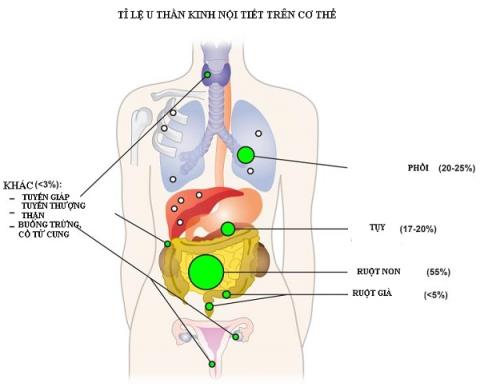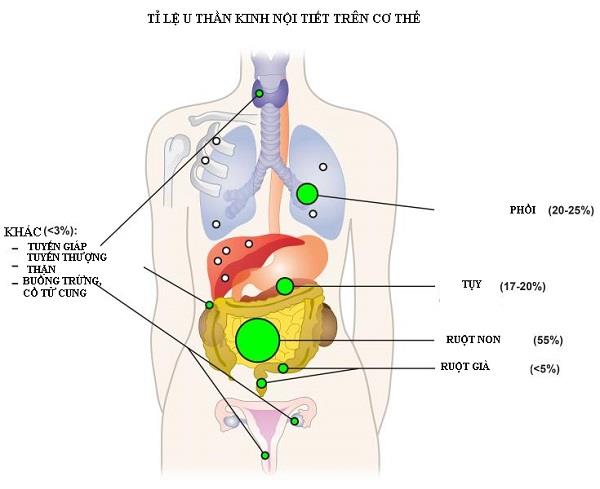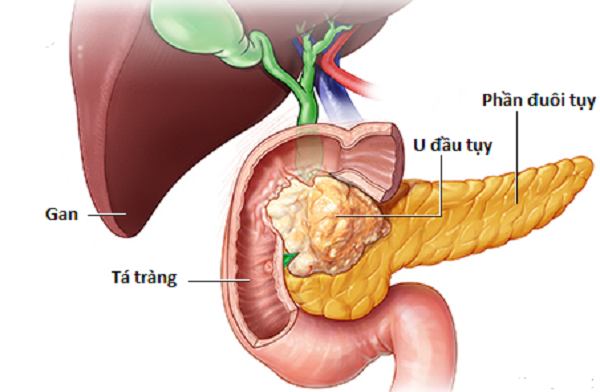Neuroendocrine tumors: A group of cancers that are easy to miss

Cancer is currently a group of diseases that cause many negative effects on human health. The degree of malignancy of the cancer depends on the location and the degree of differentiation of the cells. In this article, we will learn about neuroendocrine tumors. This is a group of cancers that are capable of secreting target organ hormones. Thereby disrupting the function of that organ in the body.
content
- 1. What is a neuroendocrine tumor?
- 2. Classification of Neuroendocrine Tumors
- 3. Causes of Neuroendocrine Tumors
- 4. Symptoms of Neuroendocrine Tumors
- 5. How is neuroendocrine tumor diagnosed?
- 6. Treatment of Neuroendocrine Tumors
1. What is a neuroendocrine tumor?
- This group of diseases are cancers that start in the neuroendocrine cells. These cells have similar characteristics to neurons and endocrine cells. That is, they are both capable of neurotransmitters and have the ability to produce hormones.
- Most neuroendocrine tumors grow more slowly than other cancers. Often they are only discovered years later compared to several months for other cancers. In addition, there are cases of early detection due to overexpression of endocrine function.
- Neuroendocrine tumors are rare and can occur anywhere in the body. Most tumors occur in the lungs, appendix, small intestine, rectum, and pancreas. Some grow slowly and some grow very fast. If a neuroendocrine tumor produces excess hormones, it is called a functional neuroendocrine tumor. If the tumor does not secrete hormones or does not secrete enough to cause symptoms. Called Non-Functional Neuroendocrine Tumor.
- The diagnosis and treatment of neuroendocrine tumors depends on many factors:
- Tumor type.
- Location of the tumor.
- Neuroendocrine tumors are functional or not.
- Malignancy, size and extent of invasion and metastasis of the tumor.

2. Classification of Neuroendocrine Tumors
Neuroendocrine tumors are classified according to the organ in which the tumor occurs:
2.1 Digestive tract
- It is the most common site to detect neuroendocrine tumors. In which, especially in the small intestine (19%), appendix (4%) and large intestine (20%). It is derived from primordial neuroendocrine cells located in the intestinal wall. Because it often causes digestive symptoms, it is easy to confuse it with digestive diseases. The disease is often detected at a late stage with a significantly reduced prognosis.
See also: Lower gastrointestinal bleeding: Don't take it lightly!
2.2 Lungs
- The lungs are the second most common site of NETs. About 30% of NETs occur in the bronchial system, which carries air to the lungs. The disease often causes symptoms of shortness of breath, wheezing like asthma, so it is easy to misdiagnose. Especially can cause respiratory failure complications , coughing up blood, life-threatening lightning strikes.
2.3 Pancreas
- About 7% of neuroendocrine tumors are found in the pancreas (islet cell carcinoma). The pancreas is an organ that is both endocrine and exocrine. It secretes digestive juices (exocrine), which helps with the digestion and absorption of food. In addition, the pancreas also secretes hormones that regulate digestion and control blood sugar (endocrine).

2.4 Other agencies
- Pituitary. Neuroendocrine tumor of the anterior pituitary gland.
- Thyroid. Neuroendocrine thyroid tumors, especially medullary carcinomas.
- Parathyroid neuroendocrine tumor.
- Thymic tumor and mediastinal carcinoid.
- Adrenal neuroendocrine tumor.
- In addition, many other organs can be affected such as skin, breasts, genitals, etc.
3. Causes of Neuroendocrine Tumors
Currently, the cause of neuroendocrine tumors is not clearly understood. The source of cancer cells is genetic mutations in their DNA. Neuroendocrine cells with abnormal genes will grow rapidly, abnormally forming tumors. The degree of malignancy of the cancer depends on the degree of differentiation of the tumor from the pancreatic tissue. The higher the differentiation, the lower the malignancy and vice versa. When it reaches the late stages, cells can invade other organs.
Certain genetic syndromes increase the risk of this type of cancer, including:
- Multiple endocrine glands, type 1 (MEN 1).
- Multiple endocrine glands, type 2 (MEN 2).
- Von Hippel-Lindau disease.
- Tuberous sclerosis.
- Neurofibromatosis.
There are also risk factors such as:
- Patient is male. Men are more likely than women to develop these tumors.
- There is a family history of endocrine pancreatic tumors.
- Frequent exposure to toxic chemicals.
- Lots of radiation.
4. Symptoms of Neuroendocrine Tumors
Symptoms of the disease depend entirely on the organ in which the tumor appears.
4.1 Pancreas and gastrointestinal tract
- Stomach ulcers come back again and again.
- Abdominal pain, spreading to the back.
- Diarrhea.
- Undigested.
- Gastroesophageal reflux : belching, heartburn..
- Yellow skin, yellow eyes, yellow skin.

- Blood sugar too low or too high.
- Excited heart beat fast.
- Blurred vision, muscle weakness, irritability, cramps…
4.2 Lungs
- Asthma-like symptoms.
- Shortness of breath, wheezing.
- Hot, red face.
4.3 Other agencies
- Red skin.
- Urinate frequently.
- Thirst increases.
- Dizzy.
- Trembling.
- Skin rash.
In addition, non-functional neuroendocrine tumors may have the following symptoms:
- Pain caused by a growing tumor.
- A growing lump may be felt under the skin.
- Feeling unusually tired.
- Unusually fast weight loss.
In summary, because neuroendocrine tumors are located throughout the body, the symptoms are very diverse. Because symptoms easily overlap with other diseases, this group of diseases is often misdiagnosed.
5. How is neuroendocrine tumor diagnosed?
Diagnosis of neuroendocrine tumors must combine history, physical examination and laboratory tests. Ask carefully about the symptoms of the disease, especially with people with weight loss and family history. Tests are ordered based on the individual patient's condition and the physician's assessment. Surveys may include:
Clinical examination
Examine closely for signs and symptoms of a tumor. Swollen lymph nodes or a tumor may be found at the site of the lesion. Also look for signs that a tumor is producing excess hormones.
Tests to look for excess hormones.
Your doctor may recommend blood or urine tests to look for signs of excess hormones. Identifying excess hormone can also preliminarily localize the tumor location.
Imaging test.
Ultrasound, CT and MRI, to create images of the tumor. This not only helps in assessing the tumor but also its stage. Investigation of tumor metastasis and invasion.
Radionuclide images
Sometimes images are created using positron emission tomography (PET). Nuclear imaging is indicated when other imaging tests are not clear.
Biopsy
Cut a sample of neuroendocrine tumor tissue to examine its histological properties. Usually this procedure involves just a needle through the skin, but sometimes surgery is also needed. When the tumor is deep or covered by another organ, surgery is needed for a biopsy. Biopsy helps to diagnose the nature and differentiation (malignancy) of the tumor.
If there is a risk that neuroendocrine tumors have spread to other organs, more specialized testing is needed.
6. Treatment of Neuroendocrine Tumors
Treatment of endocrine pancreatic tumors varies based on:
- Cancer type.
- Stage of the disease.
- The patient's overall health.
Options may include:
-
Surgery
Surgery is used to remove the tumor. When possible, surgeons remove the entire tumor. If the tumor cannot be completely removed, it can help to remove as much of it as possible. Often, if there is no metastasis or invasion of surrounding tissue, surgery can completely remove the tumor.
-
Valence
Chemotherapy uses strong chemical drugs to kill tumor cells. It can be given through a vein in your arm or taken as a pill. Chemotherapy may be recommended if there is a risk that the tumor may recur after surgery. It can also be used for advanced tumors that cannot be removed with surgery.
-
Targeted therapy
Targeted drugs focus on specific abnormalities present in tumor cells. By blocking these abnormalities, the drug can cause tumor cells to die. Targeted therapy is often combined with chemotherapy for advanced tumors.
-
Peptide radionuclide therapy (PRRT)
PRRT combines a drug that targets cancer cells with a small amount of radioactive material. It allows radiation to be delivered directly to the cancer cells. The PRRT drug, lutetium Lu 177 dotatate (Lutathera), is used to treat advanced nerve tumors.
-
Medicines to control excess hormones
Mainly for symptom control due to increased hormone levels.
-
Radiotherapy
Radiation therapy uses powerful beams of energy to destroy tumor cells. Some types of tumors may respond to radiation therapy. It may be recommended if surgery is not an option.
Some other methods can be applied depending on the condition of each patient.
Neuroendocrine tumors are a very diverse group of cancers. The disease varies greatly from symptoms to prognosis depending on many factors. Because the symptoms easily overlap with many other diseases, the diagnosis is easy to miss. Symptoms should be monitored for prompt treatment. The disease can be cured if in early stage. Regular health check-ups and risk screening are the only ways to detect this dangerous group of diseases early.
Doctor Luong Sy Bac